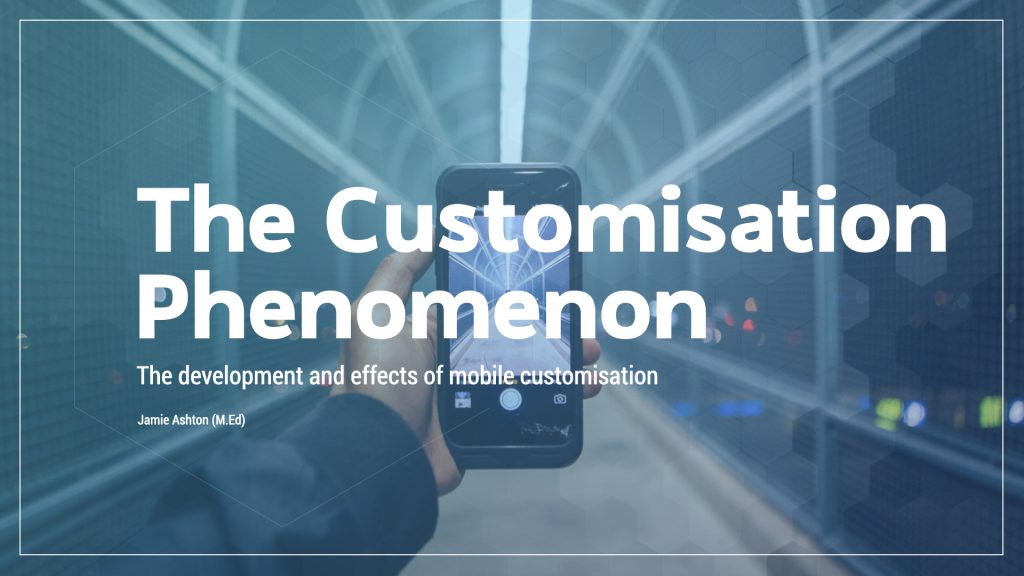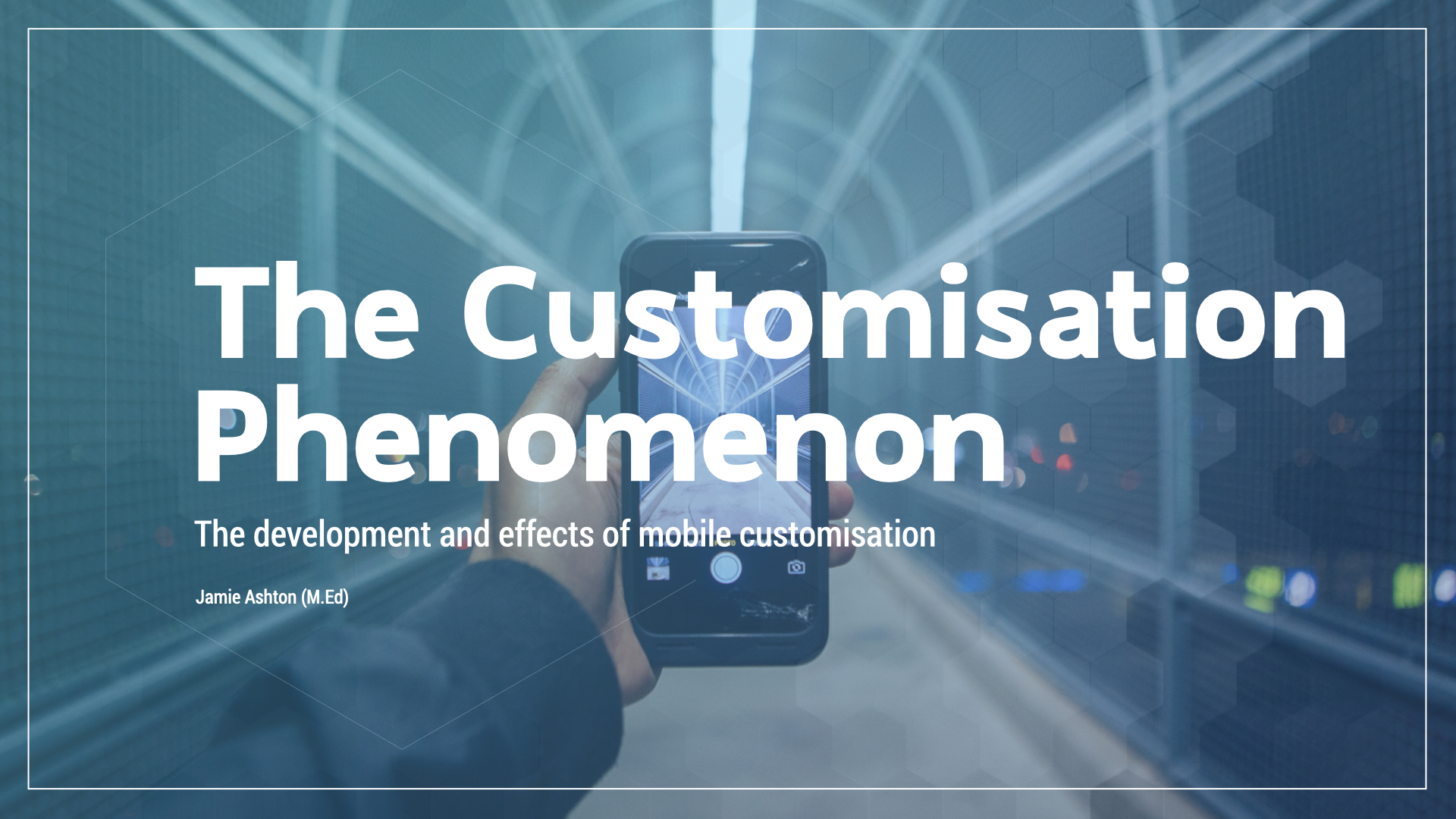I have been fascinated with the trends of device customisation on mobile phones, and how this is an assumed part of mobile culture. The extent to which this reflects individual preferences and the way it is a culture that we subscribe to also has interesting implications for mobile and open education. I thus decided to put together a short analysis of what I have termed “The Customisation Phenomenon” on mobile phones by looking at the history of this, the related theories, and the things we can infer for the design and implementation of mobile and open learning.
I decided to do my A1 in a downloadable ebook/e-pamphlet version because mobile and open learning is still currently spread between online and offline spaces. People also enjoy being able to disconnect but continue learning (I know I do this when I need to study but don’t want to receive messages). This format thus allows both online access and offline viewing. It’s layout and design is catered to laptop, tablets, and phone screens and can be easily zoomed into. The colour scheme is made to be genlte on eyes for ease of reading and viewing after long times on screens. Finally, the document size is small and thus can be saved without demanding much space, and can be accessed without long loading times.
You can view and/or download the document by clicking on the image below.

References
Andersson, C (2006). Mobile media and applications – from concept to cash: Successful service creation and launch. Chichester, England; Hoboken, NJ;: Wiley.
Blom, J. O., & Monk, A. F. (2003). Theory of personalization of appearance: Why users personalize their PCs and mobile phones. Human-Computer Interaction, 18(3), 193-228.
Boris Herbas Torrico & Björn Frank (2019). Consumer desire for personalisation of products and services: cultural antecedents and consequences for customer evaluations, Total Quality Management & Business Excellence, 30(3), 355-369.
Caron, A., & Caronia, L. (2007). Moving cultures : Mobile communication in everyday life. MQUP.
Goggin, G. (2006). Cell Phone Culture. London: Routledge.
Ito, M. (2005). Personal, portable, pedestrian : Mobile phones in Japanese life. The MIT Press.
Kuksa, I. & Fisher, T. (2017). Design for Personalisation. London: Routledge.

What a great presentation. Just wordy enough to transmit all the required info, without being overwhelming. I had no idea that mobile phones were at market as early as 1993 – that was a bit of a shock. And I loved that you referred to the early 2000s as the “Golden Age”. It’s apt and probably quite accurate, but it’s also relatively recent. I guess that speaks to the speed at which the technology is moving. I wonder when the 50s was first referred to as the Golden Age of Television?
In any event, great job!
Hi Tyler,
Glad you liked it, and that the balance was right. Crazy to think phones were around in the early 90’s hey?! That was the year I was born, which means I literally got to live the trajectory of mobile phone development.
The phones of the early 2000s just represented that sweet spot for me. Phones were interesting and integrated, but not all consuming yet. Exciting and new, but in a comfortable way. Google was very vague on when we started calling the 50s the golden age, although there is a lot of good info out there on why.
Thanks for the feedback 🙂
J
Great project! It has been interesting to see customization take off more here in Canada. When I lived in Egypt I found it to be much more prominent, mostly because it is very much a “mobile first” society. Mobile data was inexpensive and getting reliable Internet at your home was difficult. I lived there for 3 years and never had Internet at home so I used my phone as my primary device for nearly everything I did online. I would definitely say that my Egyptian friends were way ahead of the Canadians I knew in terms of customization.
Interesting insight. Now that you mention it, I saw similar things when I lived in China and Korea. There is generally more reliance on mobile devices. In Canada, phones are a convenience item that plays second fiddle to a more powerful device at home – at least more often than in these described countries. I’m curious to know the reasons for that but I suspect there are many and they are varied.
Hey Megan, Hey Jonathan!
I saw similar things in China and Thailand, too. In South Africa its interesting, because mobile societies are huge but device affordability and cost of data is still keeping large-scale mobile integration at bay.
There are indeed many varied reasons for this, and lots of research articles that are great reads about it on the UBC library site. Would recommend a quick search on there if this interests you further 🙂
J
Jamie, fantastic A1, information and presentation! I love the connections you’ve made in this, and especially conveying that learners need more customization control over their learning experiences. I interpreted this on different levels, but the following response is purely about the importance of being able to customize online learning environments/tech tools. I use dark mode on almost everything, use group tabs in Chrome (on laptop to organize), and love learning about little hacks in platforms to make them work for me. There are so many things about the LMSs and tools I use that I wish I could tweak and customize to suit my preferences and needs. I wonder if some of this is possible within Canvas – I can imagine how great it would be if I could set my own home page in Canvas, change to dark mode, create a dashboard, or build customizable actions (grab all the readings for the week to skip the steps of singly clicking all of them, logging into library, clicking through different pages to finally download, etc.) I’ll have to go explore and see what’s possible. Thank you!
Also! The stock photos you used are diverse, inclusive, and representative and I thought that was great!
Hey Mel!
Idea sparks are flying as I read your comment. I do very similar customisation to my mobile and device use, and would be curious to discover what you find about Canvas. The big thing though becomes the ease of customisation – If we need to go look for customisation settings and they’re complex to implement, it becomes less desireable/intuitive to use (could be argued that it teaches new literacies, though).
I’m glad you like the stock images – representation of diversity is a tough thing to find (95% of stock photos are caucasians in the west), so I put a lot of effort in trying to subtly include a better attempt at the range of humans that exist in our shared world 🙂 Thanks for noticing that, it means a lot.
J
Hi Jamie,
This is such an interesting topic! To view cell phone use as a semiotic activity in which customization acts as a tool for both communication/expression and creation of culture is a powerful conception. It is so true that the phone you have reflects who you are – the colour, the cover, the accessories, the background, the ringtone, and the apps etc. Speaking of co-production, re-make and re-mix, I recall an advertisement I saw on Instagram, “Take a photo. Sit back. Create all day long” – from Enlight Pixaloop, one of Google Play’s Best Apps of 2019. You are right, “customization and allowing individuals to ‘re-make’ things that they encounter is now a part of standard consumer mobile culture”. Thanks again for your wonderful presentation!
BTW, did you use Keynote to create this presentation? It looks gorgeous on the phone.
Hi Ceci!
Glad you enjoyed it – took me a while to settle on this topic. I did indeed use Keynote – I love it as a creative app. It’s really got incredible functionality!
J